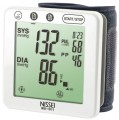Batteries
The type of batteries used in blood pressure monitors.
— AA. One of the most common types of batteries today. Voltage — 1.5 V. One of the main advantages of this type of power supply is availability:
AA batteries are sold almost everywhere where any batteries are sold at all.
— AAA. A kind of reduced analogue of AA batteries (see above) with the same operating voltage of 1.5 V.
AAA batteries are also very common, and the dimensions allow them to be used in more compact devices.
Battery indicator
Here, it refers to a
battery level indicator on the blood pressure monitor display, showed as an icon similar to those found on mobile phones. While the charge indication is typically approximate, this feature allows users to monitor battery status and prepare for replacements in advance.
Cuff dimensions
The cuff's applicable range includes both the minimum and
maximum circumferences of the upper arm or wrist (see "Place of measurement"). Modern blood pressure monitors typically feature cuffs suitable for individuals with average physique, covering the majority of adult patients. However, for specialized cases, such as monitoring a child or someone with a larger bicep circumference, it is advisable to measure the arm circumference and compare it with the specified cuff sizes.
—
Small. The small cuffs are designed for a shoulder girth of 17-22 cm.
—
Standard. Standard cuffs cover a shoulder girth of 22-32 cm.
—
Oversized. Oversized cuffs have a girth of 22-36 cm.
—
Universal. Cuffs for both thin and large people. Universal cuffs provide a shoulder girth of 22-42 cm.
—
Large. Large cuffs with a girth of 33-46 cm are suitable for a full arm or a muscular shoulder of a conditional bodybuilder.
Functions
—
Pulse measurement. The ability to use a blood pressure monitor to measure heart rate (pulse). This frequency, along with blood pressure, is one of the most important indicators of the state of the cardiovascular system.
—
Determination of arrhythmia. Blood pressure monitors with this feature are able to track irregularities in the heartbeat (arrhythmia) — one of the important signals of health problems — and warn the user about it.
—
Medium pressure calculation. This function allows you to automatically calculate the average pressure based on several consecutive measurements.
—
Signal about measurement errors. Blood pressure monitors with this function are able to display error signals that can affect the accuracy of measurements — such as incorrect cuff application, air leakage from it, movement during measurement, device electronics failure, etc.
—
Auto switch-off. Most semi-automatic and automatic models of blood pressure monitors are able to automatically turn off after a few minutes of inactivity. This saves battery power.
—
Synchronization with PC. In this case, a wired connection is implied, not
Bluetooth. Synchronization of the blood pressure monitor with a PC allows you to track
...all the measurement results in one table (in some models — even with the date and time), save the results to the PC, freeing up the device's memory, select measurements for calculating the average pressure, etc.
— Bluetooth. The presence of wireless data transfer technology allows you to use the features described in the paragraph "Synchronization with a PC" by connecting to a smartphone and using a special application. This method is more mobile, easier and faster.
— Voicing the measurements. Such blood pressure monitors are able not only to display the measurement results on the screen, but also to voice them, which can be very useful for elderly people with poor eyesight.
— Date and time indication. Having the ability to display the current date and time is useful for recording blood pressure measurements and tracking them over time. Blood pressure monitors equipped with a clock and calendar feature can automatically store measured pressure results in memory, associating them with specific date and time stamps when there is a recording mode.
— WHO colour scale. The World Health Organization has established standards defining normal, low, or elevated blood pressure values. These standards incorporate a color scale that, after each measurement, aids in assessing the pressure status and determining appropriate actions. It's important to note that individual variations exist, and what constitutes normal pressure differs for each person. Therefore, these standards are generally advisory, providing guidance rather than prescribing specific actions.
